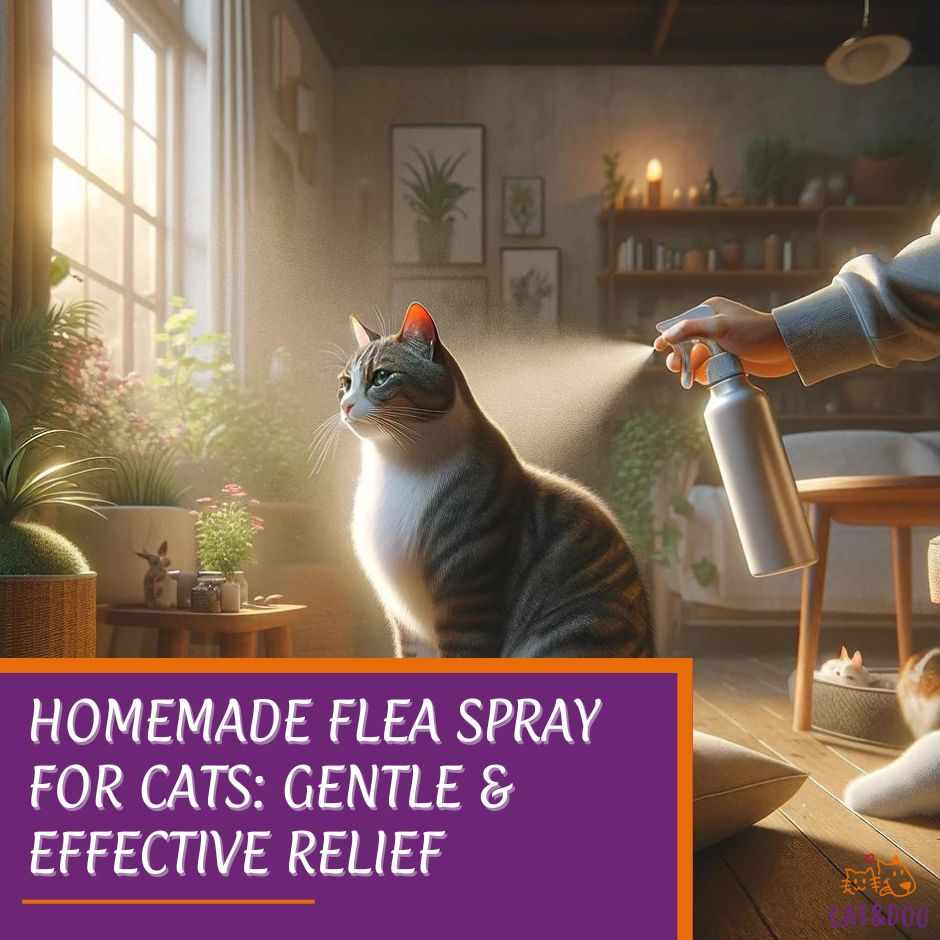When you notice your feline friend scratching a little too frantically, you might worry about a flea infestation – a common yet irksome issue for cats and their companions.
But in the spirit of safety and naturality, have you considered concocting your flea repellent? It’s gentler on your cat’s sensitive skin and friendly to your living environment. (1)

This article aims to arm you with the knowledge to create and use homemade flea spray for cats that effectively deters these pesky pests without introducing harsh chemicals into your home.
We’ll explore natural ingredients that can keep your furry pals flea-free and ensure that their well-being remains at the forefront.
Key Takeaways
- Natural flea control is crucial for your cat’s comfort and health.
- Homemade solutions offer a safer alternative to chemical treatments.
- Effective application of flea remedies enhances their success.
Homemade Flea Spray for Cats: Comprehensive Guides
Lemon Flea Spray
Fancy making your cat a citrus shield against fleas? Grab a lemon (or two) and chop them up. Boil in water and let the slices steep for a few hours.
Strain the liquid, pour it into a spray bottle, and voilà—your lemon flea spray! Here’s the simple rundown:
- Slice a lemon and boil in water.
- Allow the mixture to steep.
- Strain and transfer to a spray bottle.
- Mist your cat’s bedding and favorite hangouts.
Vinegar-Based Flea Repellent
Oh, the wonders of vinegar! Not just for salads, it’s a flea nemesis too. Making your vinegar-based flea spray is a breeze. Just mix equal parts vinegar and water in a spray bottle.
Add a few drops of essential oils if you’d like a fresher scent. And there you have it:
- Blend: 1 part vinegar to 1 part water
- Enhance: Add essential oils (optional)
- Spray: Target bedding, carpets, and furniture
Herbal Solutions
Herbs, the garden’s gift, can be your cat’s flea fortress. Rosemary, lavender, and mint are not just lovely in the garden, they’re also flea-repellent powerhouses. (2)
Simmer these herbs in water, strain, cool, and use the concoction to spritz around. Behold the herbal alchemy:
- Simmer: Selected herbs in water
- Cool: After straining the mixture
- Apply: Lightly spray on pet bedding
Remember, your cat’s comfort and safety are paramount. Always test a small patch first and consult your vet before going full herbalist. No more itching and scratching—just purring and napping!
Applying Homemade Flea Sprays Safely and Effectively
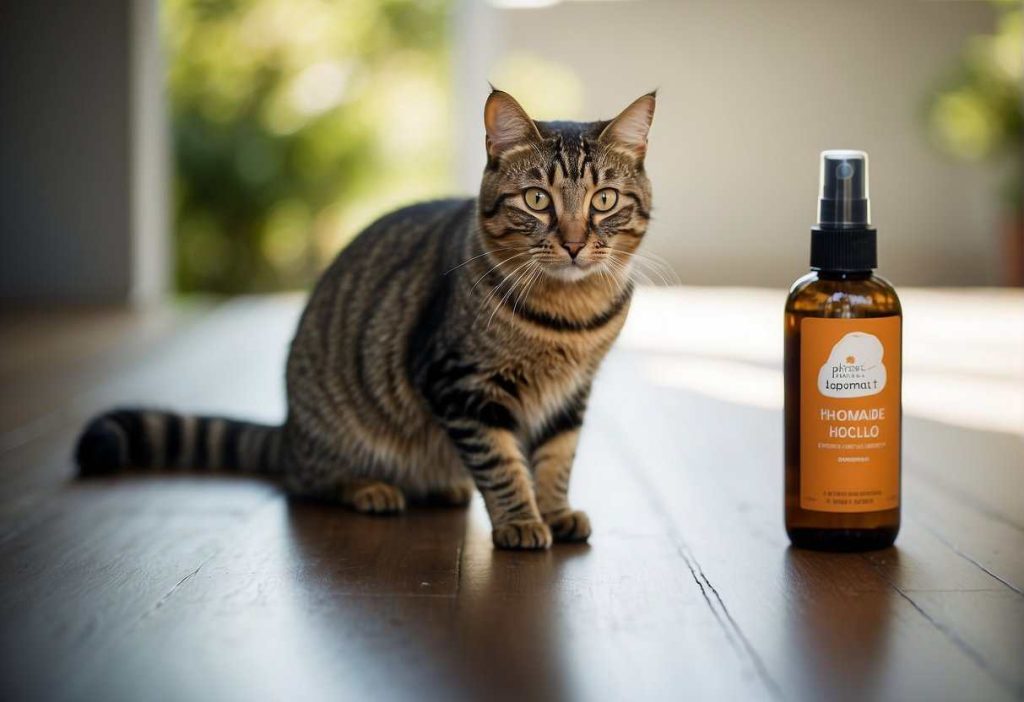
Wondering how to keep your furry friend flea-free without triggering a kitty meltdown? Getting rid of those pesky intruders is vital, but doing it safely is just as important.
Here’s how to apply flea spray in the most cat-friendly way possible!
Correct Application Techniques:
- Test a patch: Before anything else, try the spray on a small area of your cat’s skin to ensure there’s no irritation.
- Avoid the face: No one likes spritz in the eyes! Spray onto your hands and gently rub into the fur around the neck and ears.
- Keep it light: A good rule of thumb is to mist, not douse. You’re going for a sprinkle, not a cat shower.
- Soothing strokes: Calm your kitty with soft pets while applying the spray to transform the experience from scary to spa-like.
Best Practices for Stress-Free Application:
- Quiet please: The hiss of a spray bottle can be frightening, so how about a silent spray or a soft cloth application?
- Associate with positive: Pair the flea spray routine with treats or play to build a positive connection.
Frequency and Timing of Applications:
- Read the room: Picking a calm moment can make all the difference.
- Stick to a schedule: Regular applications are key. Once or twice a week should do the trick, but follow the specific recipe’s advice.
| When? | Action |
|---|---|
| Initial | Apply flea spray after patch test |
| Weekly | Reapply lightly as needed |
| After Play | Post-grooming is a purr-fect time |
A bit of vigilance and a gentle touch can make flea prevention a breeze!
Now go forth, armed with your homemade remedy, and protect your feline overlord from those pesky fleas without causing a whisker out of place. 🐱💪
Safety Precautions for Using Homemade Flea Remedies
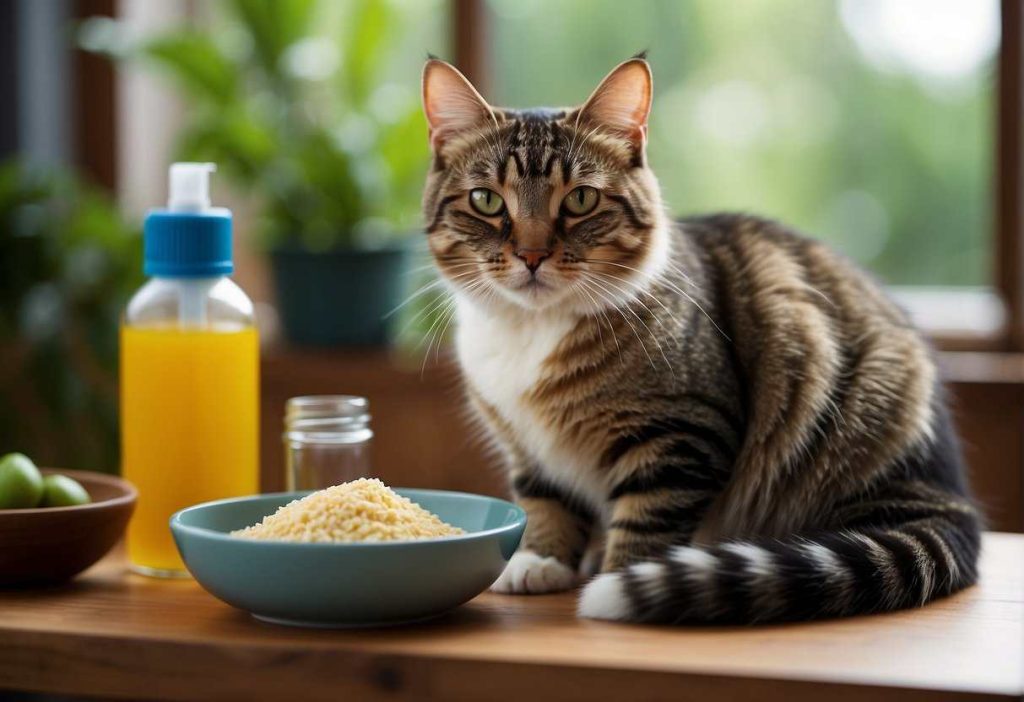
When you decide to whip up a flea remedy in your own kitchen, it’s just as important to think about what not to use as it is to focus on the ingredients you’re mixing.
Cats are sensitive creatures, and the wrong substance can do more harm than good.
Essential Safety Tips:
- Test a small area: Before applying any homemade spray to your cat’s coat, test it on a small area to ensure there’s no adverse reaction.
- Watch for allergies: Keep an eye on your feline friend for signs of allergies or skin irritation, such as excessive scratching or redness.
Have you ever wondered what might be lurking in your kitchen that could be a no-go for your cat? Some natural ingredients can be toxic!
Ingredients to Avoid:
| Harmful to Cats | Safer Alternatives |
|---|---|
| Essential Oils | Diluted Apple Cider Vinegar |
| Garlic & Onions | A Flea Comb |
| Alcohol | Mild Dish Soap |
Be sure not to substitute these harmful items, as they can lead to serious health issues. Remember, “natural” does not always mean “safe for cats.”
You might also find it intriguing that some studies suggest products like “Skin-So-Soft” have been used for flea reduction, noting a 31-62% decrease in flea populations when used as a bath solution.
Don’t you love knowing you can help keep your cat flea-free without harsh chemicals? Just be sure to stay informed and use simple, cat-friendly ingredients to keep your furry pal safe.
Try giving fruits that contain Vitamin C to help heal your cat’s skin. Vitamin C can also increase their skin elasticity.
The Science Behind Natural Flea Remedies
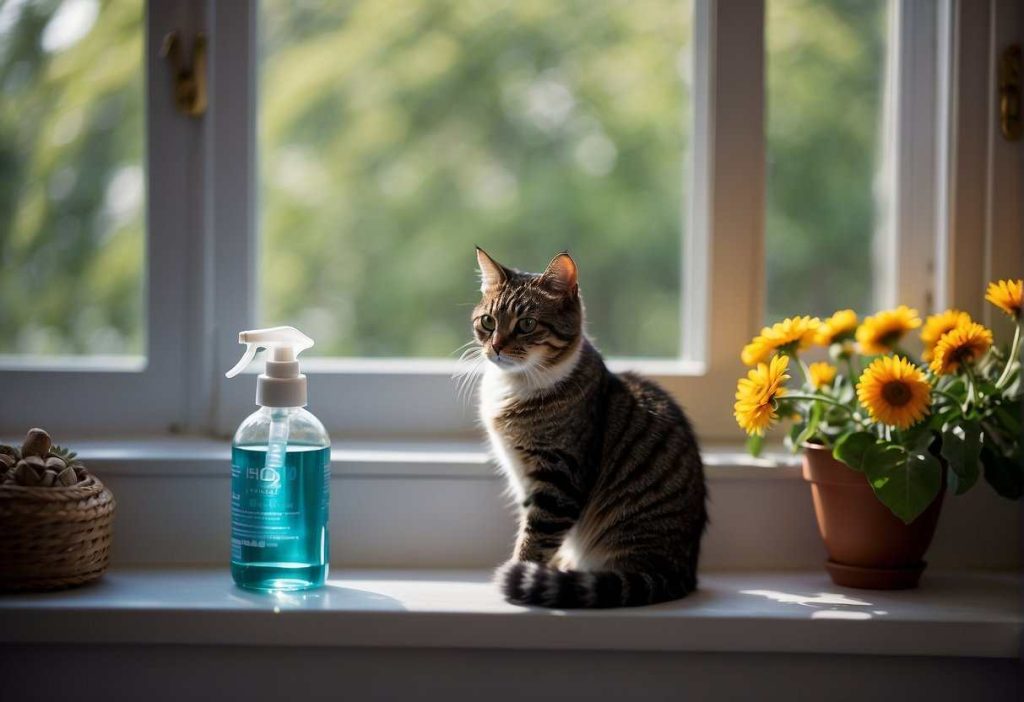
Have you ever wondered how something as simple as lemon juice or coconut oil can battle your feline friend’s fleas?
It turns out Mother Nature’s got some pretty neat tricks up her sleeve, and when it comes to natural flea repellents, it’s all about the compounds.
Natural Ingredients and Their Flea-Fighting Powers:
- Rosemary & Cumin: These herbs aren’t just for your roast—they contain compounds that can repel fleas with their strong scent. Though not fatal to fleas, they’re great at keeping them at bay.
- Apple Cider Vinegar (ACV): While ACV doesn’t kill fleas, its high acidity makes your kitty’s skin less appealing to these pests.
- Lavender & Chamomile: Known for their soothing properties, they also have the added benefit of being natural flea repellents, thanks to their scents.
- Lemon Juice: The citric acid here is not only zesty but also a potent flea killer, especially when applied directly to bedding.
Curious about customizing these treatments? Some cats may have sensitive skin, so it’s crucial to start with diluted solutions and observe for any reactions. A patch test is always smart before a full treatment.
Adjusting Remedies for Your Cat:
- Start with a weaker concentration of your chosen remedy.
- Apply a small amount to a discrete area to test for sensitivity.
- Monitor your cat for a day or two for any signs of irritation.
- If all is well, you’re good to go—keep those pesky fleas away!
Remember, your cat’s well-being comes first, and while these natural solutions can be effective, they’re not one-size-fits-all. So, take your time, and make sure it’s the right fit for your furry pal!
Understanding Fleas and Their Impact on Cats
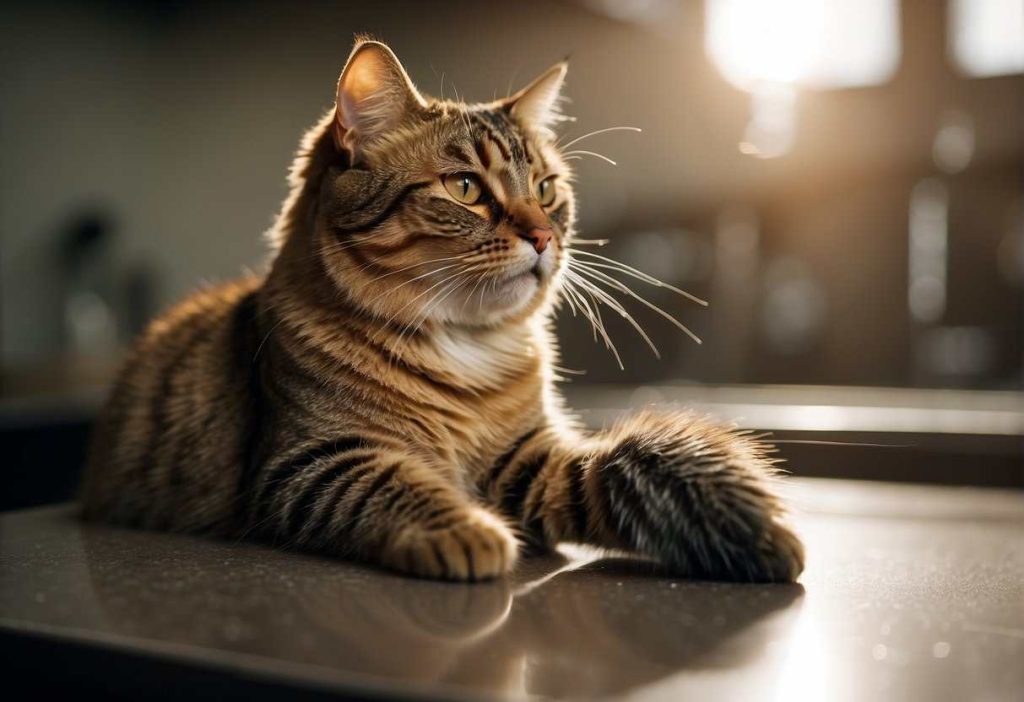
What Are Fleas?
Have you ever spotted a teeny-tiny, dark speck zooming across your kitty’s fur? That’s a flea, and it’s not just there for a quick visit. (3)
Fleas are small, agile parasites that thrive in the warm, furry coats of mammals, especially our feline friends. These critters have a life cycle that includes the egg, larva, pupa, and adult stages.
Adult fleas hitch a ride on your cat to feed on their blood, and before you know it, they’ve laid eggs to start the cycle anew.
Signs Your Cat Has Fleas (4)
Keep an eye out for:
- Excessive scratching or licking
- Red or irritated skin
- Flea dirt (looks like small black dots in the fur)
- Hair loss
- Tapeworms (which can be contracted from fleas)
Remember, spotting one flea means there could already be a full-blown infestation on your cat and in your home.
Risks Associated with Chemical Treatments
You might’ve considered those commercial flea treatments that promise quick fixes. While they can be effective, they are not without potential side effects.
Some cats might experience:
- Skin irritation
- Gastrointestinal problems (5)
- Neurological issues
Alternatives, like homemade sprays made from lemon or essential oils, can provide relief without the harsh chemicals.
Remember, though, that you’ll want to consult your vet before trying a DIY method to make sure it’s safe for your pet – because nobody knows your furry pal as your vet does!
Chat with your vet and see if going the natural route might be the better path for you and your cat.
Beyond Sprays: Comprehensive Flea Prevention Strategies

Environmental Flea Control
Ever wonder why fleas keep visiting, even though you’ve told them they’re not welcome? It might be your environment rolling out the red carpet. Keeping your home clean is like setting up a “No Fleas” sign.
Regular vacuuming disrupts their life cycle and picks up any uninvited eggs or larvae. It’s like throwing a wrench in their sinister plans!
Natural Flea Repellents for the Home
Chemicals aren’t the only bouncers you can use against fleas. Mother Nature’s got your back with some natural alternatives. Here’s a couple:
- Diatomaceous Earth: This fine powder is the bouncer that doesn’t mess around. Sprinkle it where fleas hang out, but remember, it’s for the floors, not your furball.
- Rosemary and Lavender: These aren’t just for your roast dinner. These herbs can help deter fleas when used in the home. Isn’t it nice when pests hate what we love?
Dietary Supplements for Flea Prevention
Hey, did you know what your cat eats could help in the anti-flea fight? It’s all about making them the least tasty option on the menu. (6)
Adding a bit of brewer’s yeast or apple cider vinegar to their meals might just do the trick.
But remember, no cat’s a fan of salad dressing, so keep the vinegar to a minimum and always check with your vet before changing their diet.
Long-Term Flea Management and Prevention
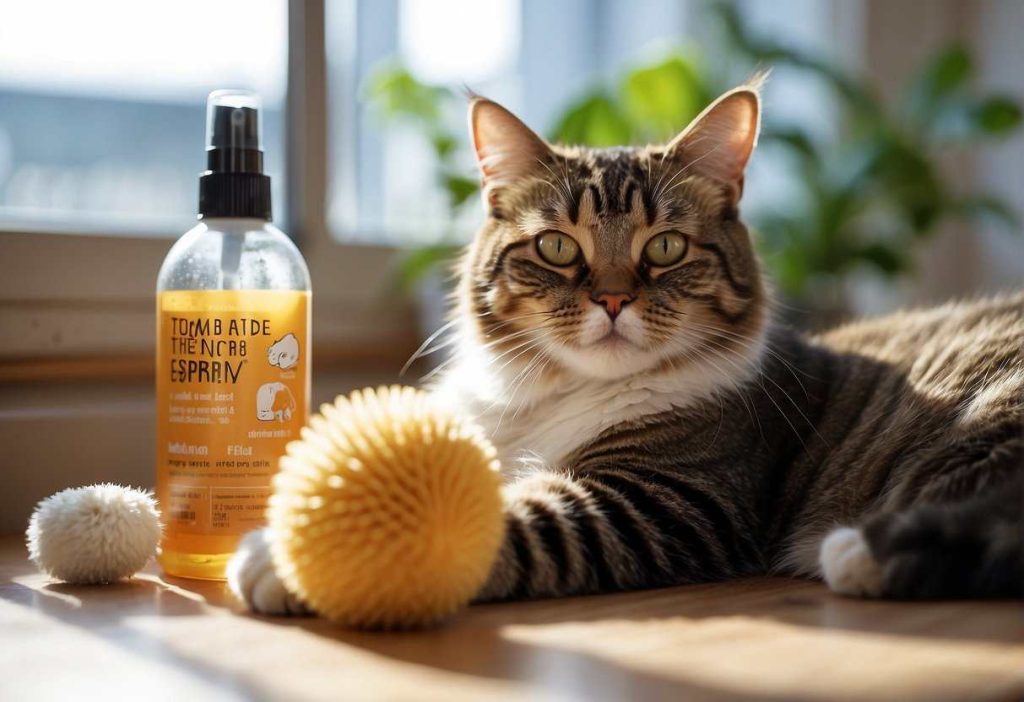
Maintaining a Flea-Free Environment
Been noticing your feline friend scratching a little too often? Fleas are the culprit more often than not, and managing these pesky critters is a marathon, not a sprint.
Luckily, you’ve got options to keep those fleas at bay over the long haul.
- Regular Cleaning: Yeah, it’s chore time! Hoovering your place regularly, especially carpets, furniture, and anywhere your cat loves to lounge, diminishes the flea population. Wash your cat’s bedding, and yours too if they’re a bed invader, in hot water weekly. (7)
- Natural Repellents: Scent-based deterrents like lemon or lavender can be part of your strategy. A light mist on your cat’s favorite spots can do wonders. Remember, when it comes to sprays or concoctions, test on a small skin area to avoid irritation.
When to Consult a Professional
Despite your best efforts, the flea circus sometimes sets up their big top in your living room.
If you’re drowning in fleas or your poor kitty can’t catch a break, it might be time to call in the cavalry—a professional pest controller. They’ve got the heavy-duty tools to evict those unwelcome guests for good.
Severe infestations are no joke, and neither is your cat’s comfort. Keep an eye out for excessive scratching, hair loss, or even flea dirt (those little black specks that are flea leftovers).
If you’re in over your head, there’s no shame in getting help.
Remember, the battle against fleas is ongoing, but with these tips, you’re well-armed to keep your furry overlord happy, healthy, and flea-free. Isn’t that peace of mind worth a little elbow grease?
Real-Life Success Stories and Testimonials
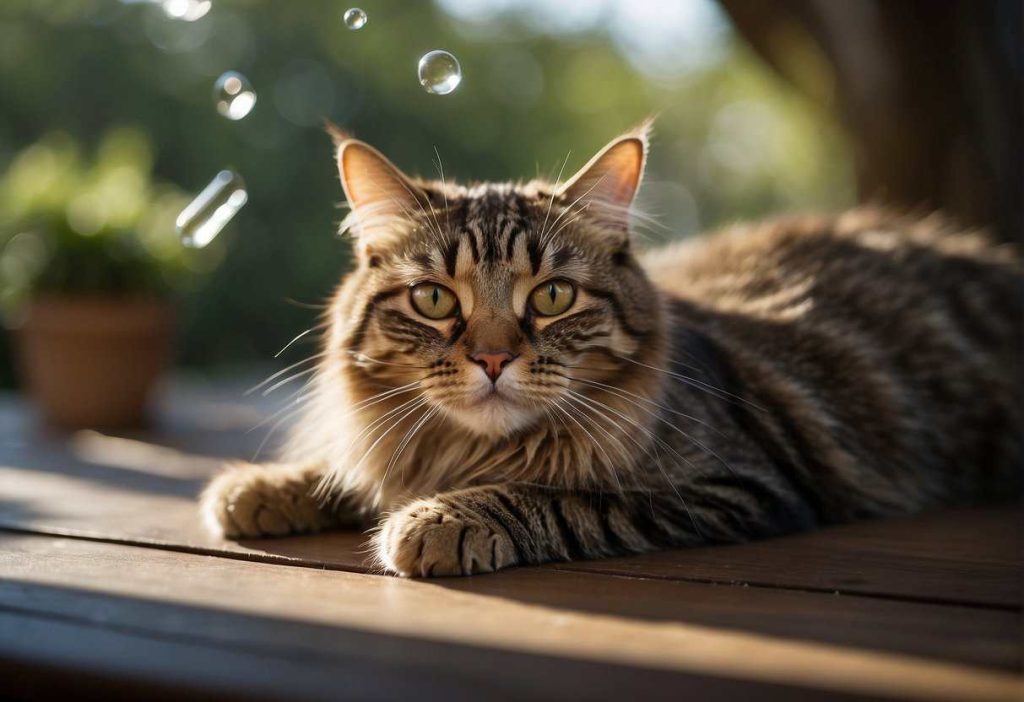
Have you ever wondered if those homemade flea sprays work? Cozy up with your fuzzy friend and check out these purr-sonal stories from fellow pet parents!
Jenny from Florida writes:
“After trying several store-bought options, I was at my wit’s end. I whipped up a lemon and rosemary concoction, and voilà, fleas be gone! My Luna is finally scratching less and snuggling more.”
Now, isn’t that a relief?
Mark in Texas shares:
- Used apple cider vinegar spray
- Noticed a decline in fleas within a week
- His cat, Whiskers, is more playful
Looks like that tangy vinegar is suitable for more than just salad dressing, doesn’t it?
Tara in California experienced:
- Immediate results with a flea comb and coconut oil
- Fewer fleas after just a couple of days
- A shinier coat on her cat, Simba
Who knew that your kitchen could be a goldmine for flea solutions?
Remember, these are just a few cases where homemade remedies have made tails wag with joy. Before trying any home remedy, it’s wise to chat with your vet – safety first, after all!
And if you’re itching to give these a try, here’s a quick rundown:
| Ingredient | Success Rate | Pet Owner’s Verdict |
|---|---|---|
| Lemon Spray | High | Fresh-smelling fur |
| Vinegar Solution | Moderate | A bit smelly, but effective! |
| Coconut Oil | Varies | Bonus shiny coat! |
This doesn’t mean every natural remedy will work for every cat, but isn’t it nice to know you’ve got options? Keep those scratchers happy and homes flea-free, one spray at a time.
Quick Recap
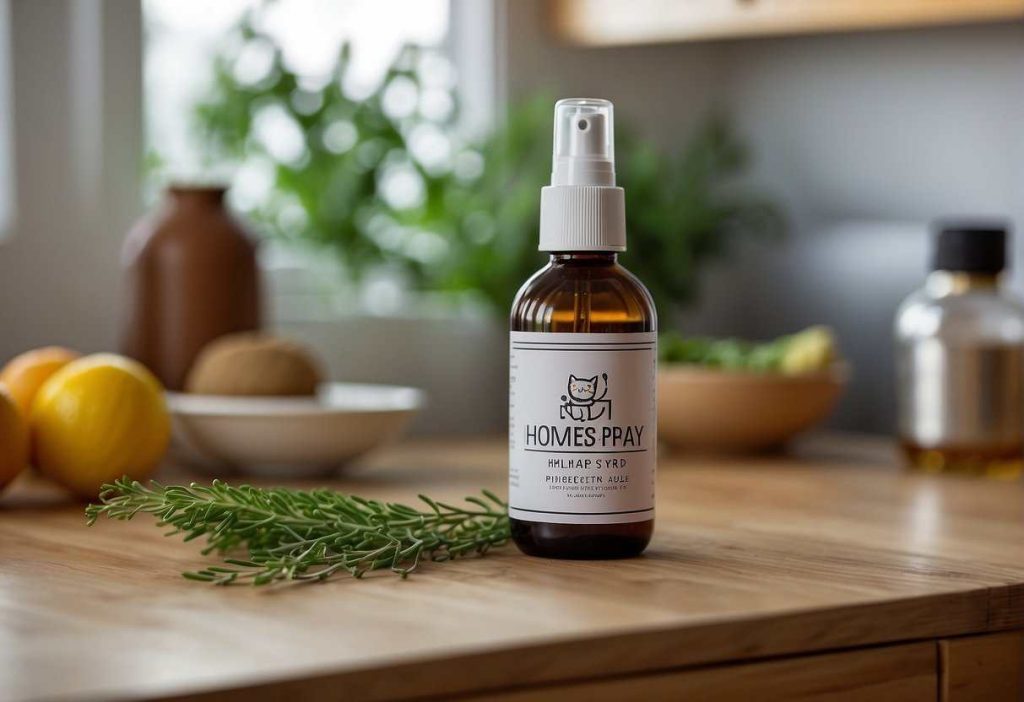
Have you tried a batch of homemade flea spray yet? Natural remedies can be both effective and cost-efficient ways to keep those pesky fleas at bay.
- Flea and Tick Repellent Spray: A staple for your furry friend’s relief, often requiring just distilled water and a few easily accessible ingredients.
- Citrus-Based Sprays: Did you know that citric acid is a flea’s worst nightmare? Boiling lemons and using the steeped solution could do wonders.
- Baking Soda Mixture: With just a tablespoon of baking soda, a teaspoon of salt, and a splash of essential oils, you have a simple concoction to rub into your cat’s fur.
- Olive Oil Option: Surprisingly, olive oil is more than just a salad dressing; it can smother those unwelcome fleas.
Here’s why sticking to natural methods can be a game-changer:
- Safety: You’re avoiding harsh chemicals that could potentially harm your cat.
- Cost: Many ingredients are already in your pantry, saving you a trip to the store.
- Convenience: These remedies are simple to whip up in the comfort of your home.
Remember, while these homemade sprays are a great help, maintaining regular grooming and a clean environment for your cat is invaluable.
Facing a flea infestation head-on can be daunting, but with these natural solutions, you’re well-equipped to keep your feline friend happy and flea-free. Have you picked your favorite recipe yet?
Frequently Asked Questions

Navigating the world of homemade flea sprays can be tricky, but with these FAQs, you’ll have the knowledge to tackle those pesky parasites with confidence!
Can I use homemade flea spray on kittens?
It’s essential to be cautious with kittens, as their systems are much more sensitive.
Consult your vet before using any homemade flea spray on kittens, especially those under 8 weeks old.
How often should I apply homemade flea spray to my cat?
Generally, you’ll want to apply a homemade flea spray every 2 weeks, but it’s important to observe your cat’s reaction and consult with a vet for the best schedule.
Will homemade flea sprays also kill flea eggs and larvae?
Some ingredients, like lemon, may help repel fleas but aren’t guaranteed to kill all eggs and larvae. Regular application and cleaning are key to managing the flea life cycle.
Are there any side effects of using homemade flea sprays on cats?
Always do a patch test first, as some cats may have skin sensitivities to natural ingredients. Watch for signs of irritation or allergic reaction.
Can I spray homemade flea spray on my cat’s bedding and furniture?
Yes, most homemade flea sprays can be safely used on your cat’s bedding and furniture.
Ensure proper drying time to prevent your cat from ingesting any of the sprays.
Can homemade flea sprays be used on other pets?
Be careful, as some ingredients safe for cats may not be safe for dogs or other pets. Always confirm with your vet before applying it to other furry family members.
How do I know if the homemade flea spray is working?
Look for a decrease in scratching and visible fleas on your cat. Regularly check their bedding and your home for signs of flea dirt or live fleas to gauge effectiveness.

